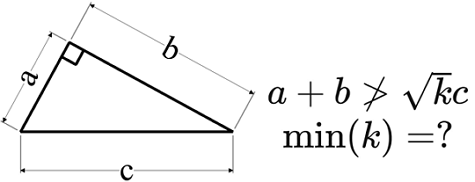Is This Another Triangle Inequality?

Find the smallest k such that the sum of the legs of a right triangle never exceeds k times the hypotenuse of the triangle.
Give your answer to 3 decimal places.
The answer is 2.
This section requires Javascript.
You are seeing this because something didn't load right. We suggest you, (a) try
refreshing the page, (b) enabling javascript if it is disabled on your browser and,
finally, (c)
loading the
non-javascript version of this page
. We're sorry about the hassle.
5 solutions
that was cool
I think there is a mistake.if a>b and c> b then a-c is not necessarily greater than 0
(k-1)(a/b +b/a)≥2 is true for k-1≥1
I have it similar, but after k-1>=2ab/(a^2 +b^2), I replaced it with 2ch/c^2, with h as the height. And since h<=c/2 (Thales) it gives you k-1>= 2 c 1/2*c / (c^2) =1 => k>=2
You subtracted the second equation from the first. If we subtract the first from the second, we get k ≤ 2 which is reverse of what you tried to prove.
The square of a real number is always greater than zero. 0 ≤ ( a − b ) 2 ⟹ 2 a b ≤ a 2 + b 2 So, ( a + b ) 2 = a 2 + b 2 + 2 a b ≤ a 2 + b 2 + a 2 + b 2 ⟹ ( a + b ) 2 ≤ 2 ( a 2 + b 2 ) ⟹ a + b ≤ 2 c Here, the equality happens when a = b .
Now, we have to find k such that the following inequality is satisfied. a + b ≤ k c k ≥ 2 satisifies the above inequality. So, m i n ( k ) = 2
He/She asked for min(k) value. You found out max value. 😐
Log in to reply
I calculated the max value of m , not k . I added a few lines for further clarity. We were asked to find the minimum k such that the inequality a + b ≤ k c holds. As we can see, k can be anything greater than 2 . So, the minimum value of k is 2 .
We shall claim that the answer is 2.
Now, let us attempt to prove it.
Let a be the length of one leg of the triangle, b be the length of the other leg of the triangle, and a 2 + b 2 be the length of the hypotenuse. Hence, we have to prove: a + b ≤ 2 a 2 + 2 b 2 ⇔ a 2 + b 2 + 2 a b ≤ 2 a 2 + 2 b 2 ⇔ a 2 + b 2 − 2 a b ≥ 0 ⇔ ( a − b ) 2 ≥ 0 This is obviously true, hence 2 is a possible value.
Obviously 1 is impossible, since triangle inequality is violated.
Thus, the smallest value of k is 2.
k need not be an integer, so the last part of your proof is invalid. However, it is easy to see that when a=b, a+b=root(2)c, so clearly no smaller k is possible.
I don't know what you guys are doing so I tried a more simplified approach: Set a=3 and b=4 (3-4-5 triangle). Then we'll get 1.96 <= k. So the answer might be 2. Turns out luck is on my side :))
One way to solve it is to maximize the hypotenuse. For a given total length of two legs, hypotenuse will be greatest when the two legs are equal.
a + b ≤ k ∗ c ,
Squaring on both the sides,
a 2 + b 2 + 2 a b ≤ k ∗ c 2
2 a b ≤ ( k − 1 ) c 2
k − 1 ≥ 2 c 2 a ∗ b
k − 1 ≥ 2 s i n ( C ) 2 s i n ( A ) ∗ s i n ( B )
k − 1 ≥ 2 1 s i n ( A ) ∗ c o s ( A ) ... ( A = 2 π − B , s i n ( c ) = s i n ( 2 π ) = 1 ) ,
k − 1 ≥ s i n ( 2 A ) ,
k ≥ 1 + s i n ( 2 A )
If my method is right, then min(k) will depend on either of angle A or B
Since A is in between 0 to pi/2, 0< sin(2A) <=1; How would you conclude?
Relevant wiki: Solving Triangles - Problem Solving - Medium
Let the legs of a triangle be a , b and the hypotenuse be c
We are looking for the smallest k such that
a + b ≤ k c ( a + b ) 2 ≤ ( k c ) 2 a 2 + 2 a b + b 2 ≤ k c 2 a 2 + 2 a b + b 2 ≤ k ( a 2 + b 2 ) k ( a 2 + b 2 ) − a 2 − b 2 ≥ 2 a b ( k − 1 ) ( a 2 + b 2 ) ≥ 2 a b
Now, since a 2 > 0 , b 2 > 0 , from AM-GM:
2 a 2 + b 2 ≥ a 2 b 2 a 2 + b 2 ≥ 2 a b
Therefore,
( k − 1 ) ( a 2 + b 2 ) − ( a 2 + b 2 ) ≥ 2 a b − 2 a b ( k − 2 ) ( a 2 + b 2 ) ≥ 0 k − 2 ≥ 0 k ≥ 2
The smallest natural number of k = 2